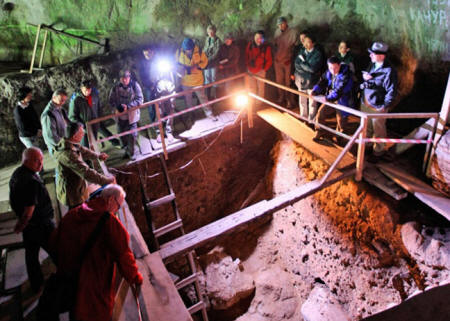|
An excavation in Denisova cave in Siberia, Russia, where remains of Denisovan hominids were first discovered.
The story of human evolution just got even more bizarre.
The genome of an extinct hominin species, the Denisovans, contains unusual snippets of DNA that seem to have come from yet another group.
It could be evidence of an entirely new species of hominin, as yet unknown to science. Alternatively, it could be our first genetic record of one of the many species known only from their fossils.
The new hominin has left its traces in the genome of a Denisovan, an extinct hominin known to exist from a finger bone and two teeth found in a Siberian cave.
Nobody knows what Denisovans looked like because there are so few fossils. But geneticists have managed to sequence their entire genome to a high degree of accuracy.
David Reich of Harvard Medical School in Boston, Massachusetts, has now taken a close look at the Denisovan genome and found that some stretches of it don't fit.
He presented his findings at a Royal Society discussion meeting on ancient DNA in London, UK, on Monday.
Distant cousins
The genome shows that Denisovans were cousins of the Neanderthals - this much was already known.
Their lineage branched off from ours around 400,000 years ago, before splitting into the Neanderthals and Denisovans.
That should mean that Denisovans and Neanderthals look equally different from modern humans, but on closer inspection, Reich found that that wasn't the case.
Specifically, scattered fragments amounting to 1 per cent of the Denisovan genome look much older than the rest of it.
The best explanation is that the Denisovans interbred with an unidentified species, and picked up some of their DNA. Or as Reich puts it:
The data looks convincing, says geneticist Johannes Krause of the University of Tübingen in Germany.
Krause is one of several geneticists who have studied the Denisovan genome and wondered if it might show traces of past interbreeding. About the only thing we know from the sparse Denisovan fossils is that they had very large teeth, which look like those of a much more primitive species.
If the Denisovans were breeding with an archaic species, that might explain their large gnashers.
Whodunnit?
The question is now:
They could be something entirely new, but Krause suspects they are a known species: many hominins are known from the fossil record but have never been genetically analyzed.
Many of these could have got frisky with the Denisovans.
The most likely candidate is Homo heidelbergensis, says Chris Stringer of the Natural History Museum in London, UK.
This species lived between 600,000 and 250,000 years ago, and spread from Africa into Europe and western Asia. That means early Denisovans, whose ancestors followed a similar path out of Africa, could well have met them.
Homo erectus is another possibility. It was even more widespread than H. heidelbergensis, living as far east as Java.
But its western populations - the ones that could have shared territory with the Denisovans - might not have survived long enough.
The question could be settled by obtaining DNA from fossils of species like H. heidelbergensis, but that is easier said than done.
The Denisovan and Neanderthal genomes have been preserved because they lived in cold, dry places. Other hominins lived in hot, wet regions where DNA breaks down quickly.
Geneticists are even now struggling to obtain DNA from a host of unidentified Asian fossils.
Whoever the mystery people were, they are a reminder that inbreeding was rife in human evolution. After our direct ancestors expanded out of Africa, they interbred with both Neanderthals and Denisovans.
And although the ancestors of modern African hunter-gatherers never left the continent, recent studies suggest they did breed with an unidentified hominin species (Evolutionary History and Adaptation from High-Coverage Whole-Genome Sequences of Diverse African Hunter-Gatherers).
That episode appears to have happened around 35,000 years ago, with a species that had split from our lineage 700,000 years ago (Genetic Evidence for Archaic Admixture in Africa).
|

